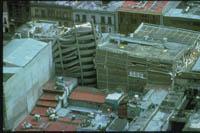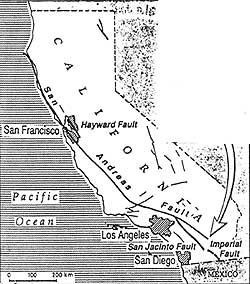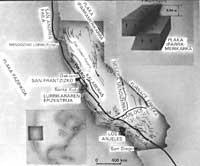Earthquakes: Destructive hidden energy
1999/02/07 Kortabarria Olabarria, Beñardo - Elhuyar Zientzia

The earthquake is only the energy that emerges sharply under the feet. Suddenly, on the terrestrial surface, the rocks that have been in tension for hundreds of years succumb and break as if they were docks that bear too much tension. The cut extends under the subsoil by sliding two blocks of rock into a fault. Depending on the power of the earthquake, the fault can circle a few centimeters or hundreds of meters. When moving against each other, the shattered rocks provoke vibration. These undesirable rubbing gives rise to seismic waves that spread across the earth, like the waves that spread when throwing a volatile stone into the water. These waves are the ones that move the earth, which are perceived on the terrestrial surface. The place where the deep rupture occurs is called hypocenter, and the equivalent in epicenter surface. Until San Francisco was destroyed in 1906, there was no connection between the failures and earthquakes. It was then verified that the shock was due to a 5 meter slide over the San Andrés fault of hundreds of meters. In addition, several types of skating were differentiated. On the one hand, they are common when, following the tension that the rock block pulls, they begin to move away in a sloping plane. In these cases the land tends to descend creating landscapes called rift. On the other hand, there are failures that occur by compression, provoking phenomena opposite to the previous one, like the formation of mountains. Finally, there are horizontal slides, one block slides against another without creating relief. San Andrés de California is one of those flaws.
The heat of the Earth is the cause of the struggle of the rock blocks, since the rocks at 2,900 kilometers of depth generate heat continuously. To maintain the thermal balance, the Earth must release this energy. Being the bad rocks conductive of heat in themselves, the giant convection currents elevate the terrestrial surface slowly. These movements are very slow, about 10 centimeters a year, but they are the ones that cause the movement of tectonic plates. In depth the rocks are solid, but they deform slowly and without breaking, while on the surface, in the first 20 kilometers, the rocks remain cold and break due to the deep movement.

80% of the seismic energy is released in subduction zones, in which the oceanic soil penetrates under the continent, hence there are so many earthquakes in Japan and the Andes. The rest of the seismic energy emerges in tectonic limits in places where continents like the Alps or the Himalayas converge. But outside of this kind of places the land is also scared. And it is that when the earth frightens, the tremors that leave the hypocenter extend everywhere. The vibrations are of two types: on the one hand, those that push and pull the rocks; on the other, those that cut the rocks, the most dangerous. The first are fast and the second are slower but stronger. The vibrations do not end with this, since the earth is not homogeneous, since the waves can reach even by rebound, causing another type of vibration. Fortunately, the waves lose strength as they move away from the hypocenter and their effect is less. The magnitude and intensity are used to measure earthquakes. The magnitude corresponds to the scale of Richter, that is, to the amplitude of the waves that measure seismographs. In addition, the magnitude is also directly related to the length of the fault and the slip size of both blocks. The intensity is only an estimate of the damage caused by the earthquake in a given place. The most affected seismic zones are earthquakes. However, there are more agents that make earthquakes more dangerous than the number of people: the power of the waves, the proximity of the hypocenter, the characteristics of the earth, the characteristics of the buildings and the time when the earthquake occurs. Some examples are: In Mexico 20.000 people died in 1985, although the epicenter of the earthquake was located 350 kilometers away, a sign of the characteristics of the land. In 1994, the magnitude 6.8 earthquake hit Los Angeles and only kills 61 people, as buildings are ready, while in Cairo, a much smaller earthquake killed thousands of people in 1992. And in 1986 an earthquake destroyed the Greek city of Calamata, but the majority of the population was at parties, so little passed. The massacres occur when these agents meet.
To combat earthquakes, as in other issues, the key is prevention. Today, however, it is impossible to predict when and where the earthquake will occur, since the mechanism that causes it is not yet known. The small earthquakes of the earth, the soiling of the water from the wells, the changes in the springs, the rarity of the attitudes of the animals and the heating of the underground waters have been considered as signs of earthquakes, but this does not provide any certainty.
In view of what is seen, that is to say, no earthquake can be predicted, which cannot be prevented and which will also cost to take the most effective measure that can be taken, back to the beginning. Man has always feared the earthquake, today he also has reasons to be afraid, and until it is possible to predict he will still have reason to fear the earthquake. Without obsessions, of course.
Published in 7

Gai honi buruzko eduki gehiago
Elhuyarrek garatutako teknologia





